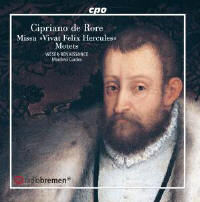Texte paru dans: / Appeared in:
|
|
|
Reviewer: J.
F. Weber
The composer’s entry in The New Grove (2000) is outdated; it has been revised for Grove Music Online (oxfordmusiconline.com). Born in a town west of Brussels, he was living in Brescia in 1542. The court of Ercole II, where he served for 13 years, was his most important post and marked his most productive years as a composer. He visited his homeland in 1558 and returned there at the end of his service in Ferrara, but went to Parma in 1560, then San Marco in 1563 (for less than a year), then back to Parma for his last year. At San Marco he succeeded Adrian Willaert, who had also served in Ferrara for 10 years.
This program begins with Ave regina caelorum, recorded by Peter Phillips; Agimus tibi gratias is on a recent disc directed by Guy Janssens that also duplicates Missa Doulce mémoire; Plange quasi virgo is on Paul Van Nevel’s disc. The first two and two others (below) were on Cordes’s earlier recording of 16 of the composer’s motets for four to seven voices (21:6). He repeats the Agimus tibi gratias from that disc, where it was prolonged by performance on instruments before singing it accompanied; here the simple unaccompanied motet is heard. Ave regina caelorum is also duplicated; in the earlier version the seven voices were divided among solo singers and players. The same approach was taken in Pater noster dividing the five voices. The only unaccompanied motet on the earlier disc, Da pacem Domine, is repeated here anew. The other four motets appear to be first recordings. On this disc he uses no instruments.
The Mass movements are separated somewhat logically (Kyrie and Gloria together, Pater noster between Sanctus and Agnus Dei). While we’re on the subject of motets of Cipriano de Rore, I have to wonder why Hesperiae cum laeta has not been recorded since an obscure Miroslav Venhoda collection in 1974. It was published by Gardano in Venice in 1549 in the Third Book of Motets. In 1986 it was the subject of an elegant book with 11 color plates by Edward E. Lowinsky, Cipriano de Rore’s Venus Motet – Its Poetic and Pictorial Sources, that was distributed to every member of the American Musicological Society by the publisher.
| |
|
|
|
|
|
|
|
Cliquez l'un ou l'autre
bouton pour découvrir bien d'autres critiques de CD |
|




